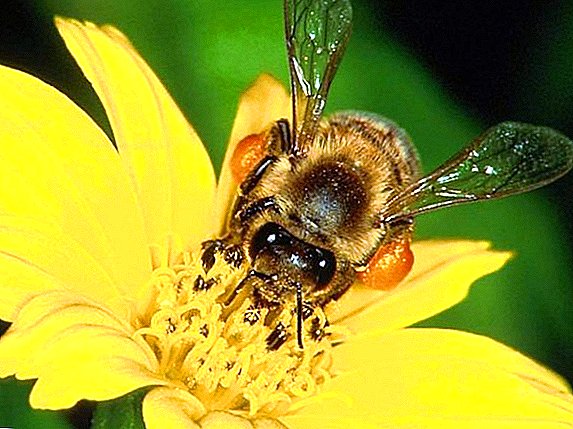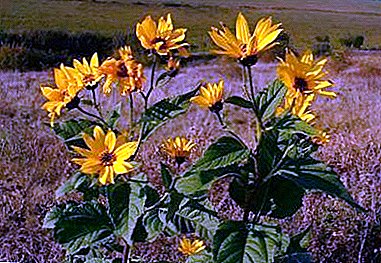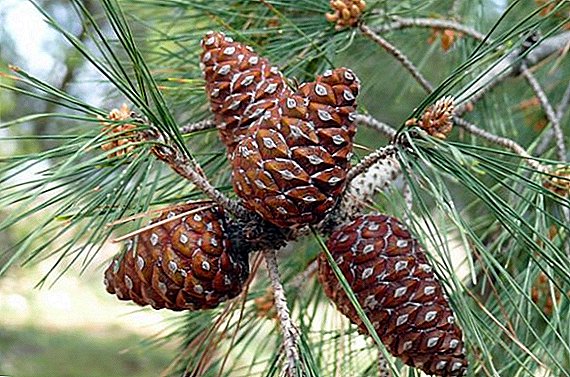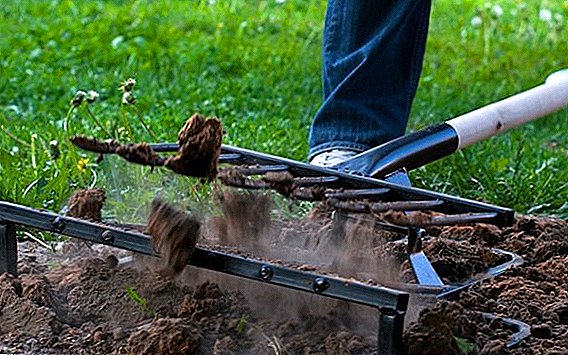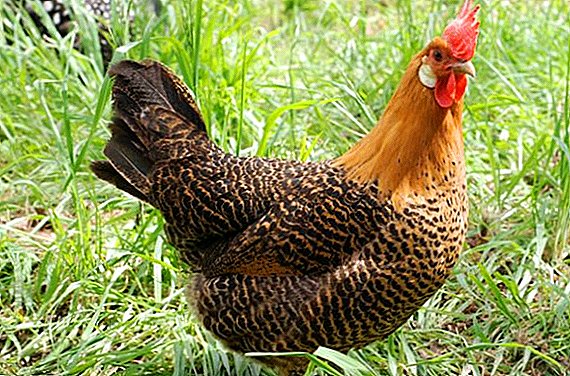 Chickens of the Spaniard breed are a collective name of several breeds of a bird, each of which originates in Spain. Spaniard combines over 20 varieties of domestic chickens. In the post-Soviet space, the five main crosses are most prevalent. It is their characteristics that we consider in this article.
Chickens of the Spaniard breed are a collective name of several breeds of a bird, each of which originates in Spain. Spaniard combines over 20 varieties of domestic chickens. In the post-Soviet space, the five main crosses are most prevalent. It is their characteristics that we consider in this article.
Productive features of Spaniards
This breed is more decorative than productive. From the Spaniards do not expect a lot of meat and high egg production. Inside the breeding championship belongs to the white face with an indicator of 180 eggs per year.
The meatiness of the Spaniards is also low: the weight of the female does not exceed 3 kilograms, the rooster is usually not heavier than 4.5 kg. Sexual maturity in representatives of this breed comes relatively early - already in half a year the chicken is completely transformed into an adult.
Spanish Chicken Varieties
The varieties of Spanish hens in our territory are represented by five crosses. The representative of each of them has a unique appearance and certain differences in character, productivity and conditions of detention.
Minorca
Description: This cross among other Spaniards stands out luxurious black, with a dark green shimmer, feathers and white earrings on the ears.  Worldwide, Minorca are considered the most popular representatives of the breed. The neck and body of these hens are elongated, the belly and wings are well developed, and the limbs are strong.
Worldwide, Minorca are considered the most popular representatives of the breed. The neck and body of these hens are elongated, the belly and wings are well developed, and the limbs are strong.
Productivity: female weight does not exceed 2.5 kilograms, rooster - 3 kilograms; egg production - 160-170 pieces per year, the mass of eggs depends on age and ranges around 60-80 grams.
Read more about the content of the Minorca chicken breed.
Content: Minorca should be kept in warm spacious poultry houses without drafts and temperature drops. During severe frosts, bird combs are rubbed with fat to avoid frostbite.
Benefits:
- quick maturing of chicks;
- high nutritional quality of eggs;
- good taste of meat;
- attractive appearance and peace loving character.

Disadvantages:
- sensitivity to damp weather and cold;
- fearfulness;
- no desire to hatch eggs.
Did you know? Chickens do not lay eggs when it is dark. Even if the time has come, the bird will wait for a day or turn on the lights, and only then will it blow.
Spanish white-faced
Description: Outwardly, these chickens are very reminiscent of the minor, the only difference that immediately catches the eye is the snow-white face. Also, the white-faced stand out among other crosses with massive white lobes. The feathering of the feathers differs from the minoroc - it is gray in the white-faced Spaniard.  Productivity: in the year chickens give 160-180 eggs. The average weight of an adult individual is identical to those of a minor minor: a chicken weighs no more than 2.5 kg, a rooster weighs no more than 3 kg.
Productivity: in the year chickens give 160-180 eggs. The average weight of an adult individual is identical to those of a minor minor: a chicken weighs no more than 2.5 kg, a rooster weighs no more than 3 kg.
Important! Properly balanced diet can significantly increase the stamina and productivity of chickens.
Content: these birds need constant walking, otherwise they will have health problems. The poultry house for white-faced Spaniards must be warm, with adequate ventilation.
Benefits:
- high egg production rates;
- bright appearance;
- rapid maturing of young.

Disadvantages:
- the need to heat the barn during the cold season (white-faced Spaniards are very thermophilic);
- increased demands on the quality of feed.
Andalusian blue
Description: representatives of this cross-country have a long, strong body and a slightly elongated wide head. The ears are light ovals, on which massive earrings are located. Legs strong, high tail with long braids.
We recommend reading about how to properly maintain the Andalusian breed Kuyu.
The whole body of the bird is covered with a thick feather of blue color. These birds have a high bright red comb. In females, it is clearly tilted back, and in roosters, it is upright.
Productivity: Mature representatives of the cross become in six months. This contributes to egg production, and in the first year the Andalusian blue gives at least 170 eggs. The weight of the male usually does not exceed 2.5 kg, the females - from 1.8 to 2 kg.  Content: Birds do not survive in harsh climates. Andalusian blue is very sensitive to overheating and precipitation, so walking must be equipped with a canopy, where chickens can hide from the scorching sun or rain.
Content: Birds do not survive in harsh climates. Andalusian blue is very sensitive to overheating and precipitation, so walking must be equipped with a canopy, where chickens can hide from the scorching sun or rain.
Perches are not recommended to be placed higher than 50 centimeters from the floor (to avoid falling and injury to birds). Lack of perches can cause deformation of the body of the Spaniard. Neighborhood with other breeds is excluded, not only to reduce the risk of fighting, but also to preserve genetic purity.
Beautiful breeds also distinguish such breeds of chickens as the sultan, Siberian pedal-throat, appenzeller, milfleur, sabo, paduan, araukan, kohinhin, phoenix, forverk, Sumatra, gudan, lakenfelder, Pavlovian golden and silver.Benefits:
- attractive appearance;
- unpretentiousness in food;
- good productivity for a family farm;

Disadvantages:
- high price;
- strong susceptibility to cold;
- propensity to colds and avitaminosis;
- lack of parental instinct.
Galloping
Description: representatives of this cross do not reach large sizes, their body resembles a rectangle. A typical external feature, apart from the absence of feathers on the neck and goiter, is a rounded chest. A small cap of feathers is formed on the nape of the neck of the neck, and on the front of the neck the feathers form a kind of bow.
The legs are short and strong, the tail is small, but fluffy and with large braids. Comb red, earrings are round. Rides may have a varied color: black, white with black spots or brown.  Productivity: the meat of these birds is tender and juicy, it resembles a turkey to taste. The average weight of a rooster is 3-3.5 kg, hens -2-2.5 kg. Mature individuals become 5.5-6 months. Egg production in the first year is 180 eggs, in the following - 150 eggs.
Productivity: the meat of these birds is tender and juicy, it resembles a turkey to taste. The average weight of a rooster is 3-3.5 kg, hens -2-2.5 kg. Mature individuals become 5.5-6 months. Egg production in the first year is 180 eggs, in the following - 150 eggs.
Did you know? Modern chickens are the distant descendants of a tyrannosaur, one of the largest predators of all time.
Content: golosheyki unpretentious in food. Their diet is identical to that of other chickens. Properly balanced feed, grain crops, grass, vegetables and root vegetables - all this can be given to bare-leg Spaniards.
Representatives of this cross, despite the absence of plumage on some parts of the body, tolerate frost well. But the temperature in the chicken coop should not fall below 0 ° C, the optimum value is 12-15 ° C. Such chickens can not tolerate drafts and high humidity, like spacious walking.  Benefits:
Benefits:
- calm character;
- high taste of meat;
- unpretentiousness in food and content.
Disadvantages can be attributed to the repulsive appearance of the bird, because of which naked hens are not very popular among farmers.
Spanish Redbro
Description: cross was obtained by crossing Malayan fighting birds and breed "Cornish". The hybrid turned out quite attractive in appearance.
The birds have a large body with dense plumage, a well developed muscular system, a large head with a bright red comb, large and bright earlobes, strong legs. Males and chickens have the same red-brown color, rarely you can meet birds with white color.  Productivity: these chickens are an exception among Spanish species. They are distinguished by good meat productivity and, with proper care, can outperform even broiler chickens in this indicator. The average weight of a redbrow chicken is more than 3 kg, of roosters - a kilogram more. The egg production at this cross is an average of -150-160 eggs per year.
Productivity: these chickens are an exception among Spanish species. They are distinguished by good meat productivity and, with proper care, can outperform even broiler chickens in this indicator. The average weight of a redbrow chicken is more than 3 kg, of roosters - a kilogram more. The egg production at this cross is an average of -150-160 eggs per year.
Content: Chickens of this cross-country are unpretentious in food and in content. The basis of the diet - grain, breading, roots. Be sure to add mineral supplements, meat and bone meal, chalk. Optimally contain redbro in rooms with the possibility of walking.
These birds tolerate cold quite well, but the temperature in the shed should not fall below 0 ° C. It is necessary to ensure that there are no drafts and excessive humidity. From time to time to arrange dust baths for birds.  Benefits:
Benefits:
- high productivity;
- good adaptability to different conditions of detention;
- quick weight gain;
- immunity to many diseases.
These chickens have one major drawback - outwardly the redbro is very similar to ordinary chickens of Russian breeds, which is sometimes used by unscrupulous sellers.
Feeding and caring for the bird
In general, the care of Spaniards is no different from the care of ordinary poultry. For many years of breeding in our latitudes, this species has become accustomed to our temperature and climatic conditions. But there are some features that must be considered breeders. 
Adults
An important condition for keeping these birds is cleanliness. Mixing feed with litter should not be allowed. Dirty food and water can eventually cause serious health problems. In chicken coops should be dry, without drafts. Like any other room for animals, the shed should be periodically treated from ticks and parasites.
It will be useful for you to read about how to make a chicken coop, an aviary, a cage, a nest and a roost for poultry.
It is important that the Spaniards are kept with the possibility of daily walking. These birds suffer from a lack of ultraviolet. The diet of Spaniards depends on age and cross. For example, only Andalusian Spaniards are whimsical in food, the rest of the hens of this species eat everything indiscriminately.
Chickens begin to feed small grains and boiled eggs, be sure to add fresh greens and boiled vegetables (carrots, beets, potatoes).  If the young growth has appeared in a cold season, and its walks in the fresh air are limited, then it is necessary to enter fish oil into the diet. When the chickens have reached the age of one month, they begin to give corn.
If the young growth has appeared in a cold season, and its walks in the fresh air are limited, then it is necessary to enter fish oil into the diet. When the chickens have reached the age of one month, they begin to give corn.
Important! Adding pure sand and chalk to the diet of chickens improves digestion.The diet of an adult chicken consists of:
- cereals;
- fresh grass;
- compound feeds;
- root crops;
- fish meal;
- corn.

Progeny
Hypothermia is the greatest threat to Spaniards in the first week of life. Babies need to be doused with warm, boiled water and heated with lamps or special electric heaters. They contain chicks in warm, dry rooms, protected from drafts.
The system for feeding chickens is no different from traditional regulations, universal for absolutely all species. The only difference is that Spaniard chicks require particularly delicate feeding with soft feed until they reach adulthood.
We advise you to read about how to properly grow and feed chickens in the first days of life, as well as how to treat and prevent chickens' diseases.
The diet should be enriched with boiled eggs, milk porridges with insignificant additives of crushed shell.
Video: proper maintenance and nutrition of chickens
Disease prevention
Standard methods for the prevention of colds and infectious diseases of ordinary domestic chickens are effective with representatives of all Spanish Hisc.
First of all, guarantee the immunity of each individual clean feeders, fresh food and water. The house should be dry, warm enough and well ventilated. Adding mineral complexes to the diet will significantly increase the resistance of the Spanish organism to diseases.
For the prevention of diseases of chickens should also disinfect the coop.
It is very important to protect the house from the possibility of penetration of rodents, because they most often are carriers of dangerous diseases. It is also worth a responsible approach to the diet of Spaniards and completely eliminate from it toxic herbs: burdock, elderberry, celandine, dandelion, white acacia, horse chestnut and hemlock.  The weak point of these chickens is the paws. Spanish women are subject to various diseases of the legs, so it is very important to conduct medical examinations in a timely manner. This will allow time to identify the disease and prevent the development of the disease.
The weak point of these chickens is the paws. Spanish women are subject to various diseases of the legs, so it is very important to conduct medical examinations in a timely manner. This will allow time to identify the disease and prevent the development of the disease.
Features molting
Shedding in Spaniard is intensive and lasts for one to two months. During this period, chickens greatly lose body weight. Shedding is a time when Spaniards are severely exhausted and devoid of their natural appeal.
Egg production rates during the molting period fall, sometimes the chickens completely cease to nest. It is important during this period to pay special attention to the diet of the Spaniards. Food must be warm to restore the energy losses of birds. Two standard feedings should be increased up to 3-4 times per day.  Spectacular appearance Hispanic finds more and more fans, despite not the highest rates of productivity of these chickens. Although these birds are not much different from ordinary domestic ones, they are often provided only by experienced bird farmers with the required housing conditions and the correct diet, therefore they remain more decorative than productive.
Spectacular appearance Hispanic finds more and more fans, despite not the highest rates of productivity of these chickens. Although these birds are not much different from ordinary domestic ones, they are often provided only by experienced bird farmers with the required housing conditions and the correct diet, therefore they remain more decorative than productive.


